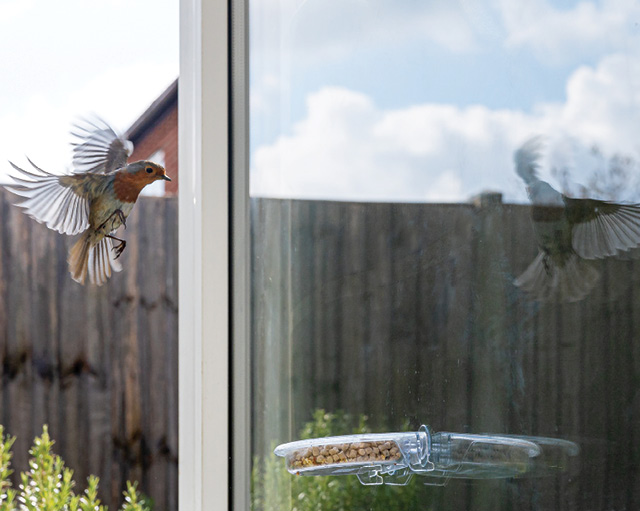Clear Solutions
Bird-friendly glass protects wildlife and benefits residential business

Many homeowners have a story to share about a bird hitting their windows. Up to 988 million bird fatalities each year in the U.S. can be attributed to window collisions. Most people are aware of commercial building owners’ efforts to minimize disruption to bird migration. What they may not know is their single-family houses and low-rise multifamily dwellings can have a greater negative impact on birds than high-rise buildings. Most collisions occur within 50 feet of the ground, where birds are most active within their habitat.
Homeowners increasingly are interested in products to preserve their outdoor views, while protecting the wildlife they enjoy. By offering bird-friendly glass, window manufacturers not only enhance safety for birds but also add value for homeowners. As the trusted experts, you can educate customers about effective bird-friendly glazing options and offer products that benefit the environment and the homeowner, as well as your business.
Why do birds collide with glass?
Glass is essentially invisible to birds, which creates three main hazards:
- Reflection. Homes located near trees, parks and water can inadvertently create dangerous flying conditions for birds. Birds mistake the reflection of trees, sky or other vegetation for actual habitat. They also can mistake their own reflection as a rival.
- Transparency. Birds try to fly through clear glass to reach what they see as the clear sky on the other side or what they perceive as a safe landing spot, such as an indoor plant.
- Black hole effect. Birds confidently fly into small openings between leaves and branches. Dark glass can appear as a safe passage or shelter, leading to fatal impacts.
Where are the market leaders?
Regulations are being enacted at local, state and federal levels to require bird-friendly designs. Some cities—such as New York, Toronto and San Francisco—already have established guidelines. Manufacturers who are early adopters of compliant, bird-friendly choices will gain an advantage in the market.
What are the best practices in bird glass design?
Sticking randomly spaced bird shapes onto an expansive window or door blocks the view and is neither attractive nor useful. Residential window manufacturers have a choice of several, readily available, effective glass options to help homeowners mitigate bird collisions. Birds need visible cues to recognize glass as a barrier.
Spacing. Research suggests markings should follow the 2-by-4-inch rule. Horizontal lines are spaced 2 inches apart and vertical lines are 4 inches apart. For areas with smaller birds, such as hummingbirds, spacing should be even tighter, such as 2 by 2 inches.
Markers. Markers should be at least 1/8 inch in size and have high visual contrast, clearly standing out against the glass and the reflected images.
Surface. Applying the markers to the outside surface of the glass (surface 1) has proven to be the most effective in deterring bird collisions under the widest lighting and viewing conditions.
What glass technologies are available?
Following the visual spacing guidelines, glass fabricators use different techniques to mark patterns birds can see without compromising the aesthetics of the window.
Etched glass. Alters the glass surface to create a light, translucent, satin appearance. It retains the light transmittance with high resistance to wear, scratching and staining.
Ceramic enamel. A permanent, screen-printed coating that is highly durable and resistant to outdoor elements.
Ceramic frit glass. Uses screen printing or digital printing methods to apply permanent coatings to any surface of the glass. These coatings have high durability with resistance to ultraviolet and weather conditions.
Decals and films. Available for existing windows and applied by a professional, these can be effective, but will require maintenance by the homeowner.
Glass laminates. Highly durable glazing systems that consist of multiple glass layers bonded together with an interlayer. Fabricators can incorporate visual markers within the interlayer or on the glass surface to deter birds.
Silicone coatings. Spray-applied using patterned stencils to the surface of the glass.
UV coatings. Appear clear to humans and can reduce the risk of collisions for birds that can see ultraviolet.
What other components can add value?
Beyond effective bird-friendly glass, window manufacturers also can expand their product portfolio with such value-added options as:
- External grilles, louvers or fine mesh screens to cover the exterior glass, which will minimize reflections. Depending on the design, this presents both a visual and physical barrier for birds.
- Overhangs and awnings also reduce reflections from above and provide shading to enhance energy-efficient home designs.
Four bottom line benefits
Investing in bird-friendly glass isn’t just about meeting regulations; it’s a business opportunity.
- Market differentiation. Homeowners increasingly care about products that protect wildlife, nature and their outdoor views. Offering bird-safe windows positions your brand as an environmentally responsible leader.
- Regulatory compliance. Staying ahead of evolving building codes demonstrates your expertise and industry leadership, while avoiding costly redesigns in the future.
- Increased demand. As more cities adopt bird-friendly ordinances, builders and homeowners may actively seek compliant window solutions.
- Sustainability certification. LEED and other green building certifications reward bird-friendly designs, making your products attractive to developers.
Bird collisions with windows are a widespread issue for homeowners. Residential window manufacturers have an opportunity to offer immediate solutions that prevent bird fatalities, improve homeowners’ comfort and enjoyment, and benefit your business.
Learn more from the National Glass Association
For more information, download NGA’s Design Guide—Best Practices for Bird-Friendly Glazing Design.